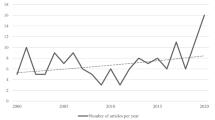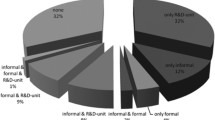Abstract
This paper is concerned with entrepreneurial high-impact firms, which are firms that generate ‘both’ disproportionate levels of employment and sales growth, and have high levels of innovative activity. It investigates differences in the influence of knowledge spillovers on high-impact growth between foreign and local firms in the UK. The study is based on an analysis of data from UK Innovation Scoreboard on 865 firms, which were divided into ‘high-impact firms’ (defined as those achieving positive growth in both sales and employment) and low-impact firms (negative or no growth in sales or employment). More precisely, the paper investigates the influence of knowledge spillovers on high-impact growth of foreign and local firms, from regional, sectoral and firm size perspectives. The findings suggest that (1) firms’ access to regional knowledge spillovers (from businesses and higher education institutions) is more significantly associated with high-impact growth of local firms in comparison to foreign firms; (2) because knowledge spillovers are more likely to occur in high-tech sectors (compared to low-tech sectors), firms in high-tech sectors are more associated with high-impact growth. Nonetheless, the relationship is stronger for local firms compared to foreign firms; (3) because small firms have greater need for knowledge spillovers (relative to large firms), there is a negative relationship between firm size and high-impact growth, but the negative relationship is greater for UK firms in comparison to foreign firms. Implications are drawn for policy and research.
Abstrait
Ce document porte sur les sociétés entrepreneuriales à impact élevé, qui sont des sociétés qui génèrent des niveaux disproportionnés de croissance d’emploi ‘aussi bien’ que de ventes, et qui démontrent une haute performance innovante. Il examine les différences de l’influence de la diffusion de connaissances sur une croissance à impact élevé entre des sociétés étrangères et locales dans le Royaume-Uni (UK). L’étude se base sur une analyse de données du Tableau de bord de l’innovation du Royaume-Uni de 865 sociétés qui ont été divisées en ‘sociétés à impact élevé’ (définies comme celles réalisant une croissance positive des ventes et de l’emploi) et sociétés à impact réduit (taux de croissance des ventes et de l’emploi nul ou négatif). Plus précisément, ce document examine l’influence de la diffusion de connaissances sur la croissance élevée de sociétés étrangères et locales, d’un point de vue régional, sectoriel et en relation avec la taille des sociétés. La conclusion suggère que: 1) l’accès des sociétés à la diffusion régionale de connaissances (provenant d’institutions commerciales et d’enseignement supérieur) est. fortement lié à une croissance élevée de sociétés locales par rapport aux sociétés étrangères ; 2) car la diffusion de connaissances survient plus fréquemment dans les secteurs de haute technologie (par rapport aux secteurs de basse technologie), les sociétés appartenant à des secteurs de haute technologie sont davantage liées à une croissance élevée. Néanmoins, la relation est. plus forte chez les sociétés locales par rapport aux sociétés étrangères; 3) car les petites entreprises ont un plus grand besoin de diffusion de connaissance (par rapport aux grandes entreprises), il existe une relation négative entre la taille de l’entreprise et la croissance élevée chez les sociétés du Royaume-Uni par rapport aux sociétés étrangères. Les conséquences pour la politique et la recherche sont tirées.


Similar content being viewed by others
Notes
Organization for Economic Cooperation and Development (OECD).
European Union.
References
Abreu M, Grinevich V, Hughes A, Kitson M, Ternouth P (2008) Universities, business and knowledge exchange. Council for industries and higher education and centre for business research, London and Cambridge
Abubakar YA (2013) Agglomeration of high-tech firms and new product innovations. LAP Lambert Academic Publishing
Abubakar YA, Mitra J (2013) The venturesome poor and entrepreneurial activity in Nigeria: the role of consumption, technology and human capital. Int J Entrep Innov 14(4):235–254(20)
Abubakar YA, Mitra J (2007) Developing a culture for entrepreneurship in the east of England: the value of social and human capital. Ind High Educ 21(2):129–143(15)
Acs JS (2002) Innovation and the growth of cities. Edward Elgar Publishing, Cheltenham
Acs ZJ, Mueller P (2008) Employment effects of business dynamics: mice, gazelles and elephants. Small Bus Econ 30(1):85–100
Acs ZJ, Varga A (2004) Entrepreneurship, agglomeration and technological change. Discusión paper on entrepreneurship, growth and public policy, MPI, Jena
Acs ZJ (2013). 6 high-impact firms: gazelles revisited. Handbook of research on entrepreneurship and regional development: National and regional perspectives, 133.
Acs ZJ, Parsons W, Tracy S (2008) High-impact firms: gazelles revisited. SBA Office of Advocacy, USA
Adams J, Smith D (2004) Research and regions: an overview of the distribution of research in UK regions, regional research capacity and links between strategic research partners. A report for the higher education policy institute. Oxford: Higher education policy institute (HEPI)
Almus M, Nerlinger EA (1999) Growth of new technology-based firms: which factors matter? Small Business Economics 13(2):141--154
Arrow KJ (1962) The economic implications of learning by doing. Rev Econ Stud 80:55–173
Audretsch B (1998) Agglomeration and the location of innovative activity. Oxf Rev Econ Policy 14(2):18–29
Audretsch DB, Dohse D (2007) Location: a neglected determinant of firm growth. Rev World Econ 143(1):79–107
Audretsch DB, Lehmann EE (2005a) Mansfield’s missing link: the impact of knowledge spillovers on firm growth. J Technol Transfer 30(1/2):207–210
Audretsch DB, Lehmann EE (2005b) Do University policies make a difference? Res Policy 34:343–347
Audretsch DB, Vivarelli M (1996) Firms size and R&D spillovers: Evidence from Italy. Small Business Economics 8(3):249--258
Birch DL (1979) The job generation process. Cambridge, MA: MIT Program on Neighborhood and Regional Change
Birch DL (1981) Who creates jobs? Publ Int 65:3–14
Birch DL (1987) Job creation in America. Free Press, New York
Birch DL (1989) Change, innovation, and job generation. Journal of Labor Research 10(1):33--38
Birch DL, Madoff J (1994) Gazelles. In: Solmon LC, Levenson AR (eds) Labor markets, employment policy, and job creation. Westview Press, Boulder
Blomstrom M, Lipsey R (1991) Firm size and foreign operations of multi-nationals. Scand J Econ 93:101–107
Bottazzi L, Peri G (1999) Innovation, demand and knowledge spillovers: theory and evidence from European regions, CEPR Discussion Paper No. 2279, London
Breschi S, Lissoni F (2001) Localised knowledge spillovers vs. innovative milieux: knowledge “tacitness” reconsidered. Papers Reg Sci 80:255–273
Brock WA, Evans DS (1989) Small business economics. Small Bus Econ 1:7–20
Brown C, Hamilton J, Medoff J (1990) Employers large and small. Harvard University Press, Cambridge, MA
Buckley PJ, Casson M (1976) The future of the multinational Enterprise. MacMillan, London
Butchart R (1987) A new UK definition of the high technology industries. Econ Trends Number 400:82–88
Caves RE (1996) Multinational enterprise and economic analysis, 2nd edition. Cambridge University Press, Cambridge
CCC (2004) Employment in the hi-tech ‘community’ in Cambridgeshire and Peterborough, Cambridgeshire: Cambridgeshire County Council Research Group, Cambridge
Chan YE, Bhargava N, Street CT (2006) Having arrived: the homogeneity of high-growth small firms. J Small Bus Manag 44(3):426–440
Chyi Y, Lai Y, Liu W (2012) Knowledge spillovers and firm performance in the high-technology industrial cluster. Res Policy 41:556–564
Cohen WM, Levinthal DA (1989) Innovation and learning: the two faces of R&D. Econ J 99:569–596
Constant EW (1980) The origins of the turbojet revolution. Johns Hopkins University Press, Baltimore
Cornes R, Sandler T (1986) The theory of externalities, public goods, and club goods. Cambridge University Press, Cambridge
Daly MJ, Campbell M, Robson G, Agher CC (1991) Job creation 1987−89: the contributions of small and large firms. Employment Gazette 99(11):589–596
Doloreux D (2003) Regional innovation systems in the periphery: the case of the Beauce in Québec (Canada). International Journal of innovation management 7(01):67--94
Doloreux D (2004) Regional innovation systems in Canada: a comparative study. Reg Stud 38:481–494
Dosi G (1984) Technical change and industrial transformation. Macmillan, London
Dunning JH (1993) Multinational enterprises and the global economy. Addison-Wesley Publishing Company, Wakingham
Edquist C (ed) (1997) Systems of innovation: technologies, institutions, and organizations. Pinter, London
Escribano A, Fosfuri A, Tribo J (2005) Managing knowledge spillovers: the impact of absorptive capacity on innovation performance. In: 32e conférence de l’Association européenne de la recherche sur l’industrie et l’économie
Escribano A, Fosfuri A, Tribó JA (2009) Managing external knowledge flows: the moderating role of absorptive capacity. Res Policy 38(1):96–105
European Commission (2002) High-tech SMEs in Europe, Observatory of European SMEs, No. 6, Enterprise Publishing
European Commission (2007) Regions in the European Union, Nomenclature of territorial units for statistics, Luxembourg: Office for Official Publications of the European Communities
European Commission (2012) EU SMEs in 2012: at the crossroads Annual report on small and medium-sized enterprises in the EU, 2011/12, Ecorys. Online. Available at: http://ec.europa.eu/enterprise/policies/sme/facts-figures-analysis/performance-review/files/supporting-documents/2012/annual-report_en.pdf (Accessed: 24th February, 2012)
Evans DS (1987a) Test of alternative theories of firm growth. J Polit Econ 95:657–674
Evans DS (1987b) The relationship between firm growth, size, and age: estimates for 100 manufacturing industries. J Ind Econ 35:567–583
Feeser HR, Willard GE (1989) Incubators and performance: a comparison of high- and low-growth high-tech firms. J Bus Ventur 4(6):429–442
Feeser HR, Willard GE (1990) Founding strategy and performance: a comparison of high and low growth high tech firms. Strateg Manag J 11:87–98
Feldman MP, Florida R (1994) The geographic sources of innovation: technological infrastructure and product innovation in the United States. Annals of the Association of American Geographers 84(2):210--229
Forbes (2015), 7 Leading accelerators for overseas startups coming to Silicon Valley. Online. Available at: http://www.forbes.com/sites/drewhendricks/2015/02/17/7-leading-accelerators-for-overseas-startups-coming-to-silicon-valley/ (Accessed: 7th October, 2015)
Gallagher CC, Daly MJ, Thomason JC (1990) The growth of UK companies 1985−87 and their contribution to job creation. Small Bus Econ 3(4):269–286
Guler I, Guillen MF (2010) Home country networks and foreign expansion: evidence from the venture capital industry. Acad Manag J 53(2):390–410
Goedhuys M, Sleuwaegen L (2009) High-growth entrepreneurial firms in Africa: a quantile regression approach. Small Bus Econ 34:31–51
Griffith R, Redding S, Van Reenen J (2004) Mapping the two faces of R&D: productivity growth in a panel of OECD industries. Rev Econ Stat 86(4):883–895
Grossman GM, Helpman E (1991) Innovation and growth in the global economy. MIT Press, Cambridge, MA
Guellec D, van Pottelsberghe de La Potterie B (2004) From R&D to productivity growth: do the institutional settings and the source of funds of R&D matter? Oxf Bull Econ Stat 66(3):353–378
Gundry LK, Welsch HP (2001) The ambitious entrepreneur: high-growth strategies of women-owned enterprises. J Bus Ventur 16(5):453–470
Guardian (2014) How many UK companies are actually foreign-owned? Online. Available at: http://www.theguardian.com/business/economics-blog/2014/sep/11/uk-companies-foreign-owned (Accessed 8th October, 2015)
Hägerstrand T (1967) Innovation diffusion as a spatial process. University of Chicago Press (A. Pred, trans)
Hall BH (1987) The relationship between firm size and. Firm growth in the U.S. manufacturing sector. Journal of. Ind Econ 35(2):583–605
Horaguchi H (1992) Foreign direct investment of Japanese firms: Investment and disinvestment in Asia. University of Tokyo Press
Horst T (1972) Firm and industry determinants of the decision to invest abroad. Rev Econ Stat 54:37–45
Jaffe AB (1989) Real effects of academic research. Am Econ Rev 79(5):957–970
Keeble D, Lawson C, Moore B, Wilkinson F (1999) Collective learning processes, networking and ‘institutional thickness’ in the Cambridge region. Reg Stud 33(4):319–332
Keen C, Etemad H (2012) Rapid growth and rapid internationalization: the case of smaller enterprises from Canada. Manag Decis 50(4):569–590
Kinoshita Y (1998) Micro-determinants of Japanese Foreign Direct Investment in Asia, Eastern Economic Association and Japan Economic Seminar, Columbia University
Knudsen B, Florida R, Gates G and Stolarick K (2007) Urban density, creativity and innovation, Working Paper, The Martin Prosperity Institute, University of Toronto
Kuemmerle W (1998) Home base and knowledge management in international ventures, Harvard Business School Working Paper 98/82
Lall R (1986) Third world multinationals: the characteristics of Indian firms investing abroad. J Dev Econ 20:381–397
Lambert R (2003) Lambert review of business – University collaboration: final report. HM Treasury, Crown copyright.
Landström H (1996) Award winner David L. Birch’s contributions to entrepreneurship and small business research, Global Award for Entrepreneurship Research
Lee N (2014) What holds back high-growth firms? Evidence from UK SMEs. Small Bus Econ 43(1):183–195
Loesch A (1954) The economics of location. Yale University Press, New Haven
Lu JW, Beamish PW (2006) SME internationalization and performance: growth vs. profitability. J Int Entrep 4:27–48
Manimala M (1999) Entrepreneurial policies and strategies: the innovators choice. Sage Publications, India
Markman GD, Gartner WB (2002) Is extraordinary growth profitable? A study of Inc. 500 high-growth companies. Enterp Theory Pract 27:65–75
Marshall A (1890) Principles of economics: an introductory, volume, 1st edition. Macmillan, London
Marshall A (1920) Principles of economics, revised edition. Macmillan, London
Marshall A (1961) Principles of economics, 9th variorum edition, C.W. Guillebaud (edn), London: Macmillan
Maskell P, Malmberg A (1999) Localised learning and industrial competitiveness. Camb J Econ 23(2):167–185
Mazzucato M, Paris S (2014) High-growth firms in changing competitive environments: the US pharmaceutical industry (1963 to 2002). Small Business Economics, 1–26.
Mitra J, William G, Jun L, Abubakar YA (2007) Developing an entrepreneurial culture in Thames Gateway South Essex. Entrepreneurship Research Project report summary. (Project Report) Southend on Sea, U.K: Centre for Entrepreneurship Research, School of Entrepreneurship and Business, University of Essex
Mowery DC, Rosenberg N (1989) Technology and the pursuit of economic growth. Cambridge University Press, Cambridge
Nachum L, Keeble D (2003) MNE linkages and local clusters: foreign and indigenous firms in the media cluster of Central London. J Int Manag 9(2):171–192
Niefert M (2005) Patenting behaviour and employment growth in German start-up firms: a panel data analysis. Discussion paper no 05-03, ZEW centre for European economic research, Mannheim
Nylund PA, Serrat NA, Hernández XF, Freixanet MF, Aliberch AS (2014) Financial and economic analysis of gazelle firms in Central Catalonia. Intangible Cap 10(5):948–984
OECD (2011) ISIC REV. 3 Technology Intensity Definition, Classification of manufacturing industries into categories based on R&D intensities, OECD directorate for science, technology and industry economic analysis and statistics division. Online. Available at: https://www.oecd.org/sti/ind/48350231.pdf. Accessed 11 Jan 2017
O’mahony M, Vecchi M (2009) R&D: knowledge spillovers and companies’ productivity performance. Res Policy 38:35–44
Osabutey EL, Williams K, Debrah YA (2014) The potential for technology and knowledge transfers between foreign and local firms: a study of the construction industry in Ghana. J World Bus 49(4):560–571
Parker S, Storey DJ, Van Witteloostuijn A (2005) What happens to gazelles? The importance of dynamic management strategy, Durham Business School, Durham
Pred AR (1966) The spatial dynamics of US urban-industrial growth, 1800--1914: interpretive and theoretical essays. MIT press
Raspe O, Van Oort F (2008) Firm growth and localized knowledge externalities. J Reg Anal Pol 38:100–116
Romer P (1990) Endogenous technological change. J Polit Econ 98:S71–S101
Romer PM (1986) Increasing returns and long-run growth. J Polit Econ:1002–1037
Rothwell R (1989) Small firms, innovation and industrial change. Small Bus Econ 1(1):51–64
Sena V, Hart M, Bonner K (2013), Innovation and UK high-growth firms, Nesta Working Paper 13/12
Senderovitz M, Klyver K, Steffens P (2015) Four years on: are the gazelles still running? A longitudinal study of firm performance after a period of rapid growth. Int Small Bus J 34(4):391–411
Saxenian A (1994) Regional advantage: culture and competition in Silicon Valley and Route 128. Harvard University Press, Cambridge, MA
Scherer FM (1991) Changing perspectives on the firm size problem. In: Acs ZJ, Audretsch DB (eds) Innovation and technological change: an international comparison. University of Michigan Press, Ann Arbor
Shuman JC, Shaw JJ, Sussman G (1985) Strategic planning in smaller rapid growth companies. Long Range Plan 18(6):48–53
Sims MA, O’Regan N (2006) In search of gazelles using a research DNA model. Technovation 26(8):943–954
Stel VAJ, Storey J (2004) The link between firm births and job creation: is there a Upas tree effect? Reg Stud 38(8):893–909
Storey DJ (1994) Understanding small firms. Routledge, London
Stuart TE, Sorenson O (2003) The geography of opportunity: spatial heterogeneity in founding rates and the performance of biotechnology firms. Res Policy 32(2):229–253
Trevino LJ, Daniels JD (1994) An empirical assessment of the preconditions of Japanese manufacturing foreign direct investment in the United States. Weltwirtschaftliches Archiv 130(3):576--599
Utterback JM (1974) Innovation in industry and the diffusion of technology. Science 183(4125):620--626
Vandenbussche J, Aghion P, Meghir C (2006) Growth, distance to frontier and composition of human capital. Journal of Economic Growth 11(2):97--127
Virtanen M, Heimonen T (2013) Longitudinal analysis of the development of high growth and success (HGS) firms-Are HGS businesses high impact firms. In: Paper to be presented in the XXVII RENT Conference, Vilnius, Lithuania
Wesson T (1997) A model of asset seeking foreign direct investment, Proceedings International Business Division. Adm Sci Assoc Canada 18(8):110–120
Willard GE, Krueger DA, Feeser HR (1992) In order to grow, must the founder go: a comparison of performance between founder and non-founder managed high-growth manufacturing firms. J Bus Ventur 7:181–194
Acknowledgments
We are grateful for the constructive comments and feedback received from two anonymous reviewers. The comments are gratefully acknowledged.
Author information
Authors and Affiliations
Corresponding author
Rights and permissions
About this article
Cite this article
Abubakar, Y.A., Mitra, J. Knowledge spillovers and high-impact growth: Comparing local and foreign firms in the UK. J Int Entrep 15, 145–176 (2017). https://doi.org/10.1007/s10843-016-0195-7
Published:
Issue Date:
DOI: https://doi.org/10.1007/s10843-016-0195-7




